Another Cool and Wacky Golf Ball Invention from Nike that Will Never Make it to the Market!
When it comes to really outside-the-box golf inventions, bordering on wacky, Nike Golf is the leader in the field. While some may argue that such a distinction is not a compliment, I think that it is and demonstrates that they are not tied down by conventional thinking. Now with that said, it sure would be nice if they brought one of their really odd designs to a commercial product instead of just dreaming and filing patent applications!
The latest unique golf ball invention is disclosed in a patent application that published recently as US Pub. No. A golf ball may include an inner core layer and an outer cover layer disposed radially outward of the inner core layer. The outer cover layer may be formed of an outer cover layer material having one or more grooves extending radially inward from an outer surface of the outer cover layer. In addition, the golf ball may include a groove material disposed within the one or more grooves. The groove material may have a compressibility that is different from a compressibility of the outer cover layer material. Also, the outer surface of the groove material may extend radially outward beyond the outer surface of the outer cover layer.
Check out these drawings!
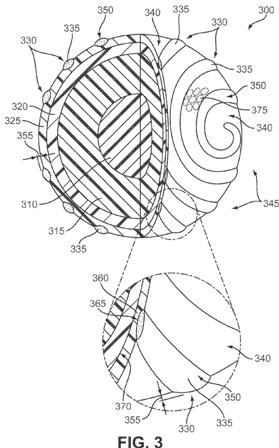
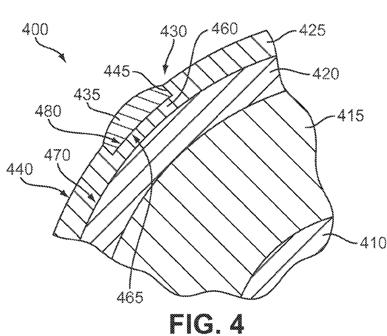
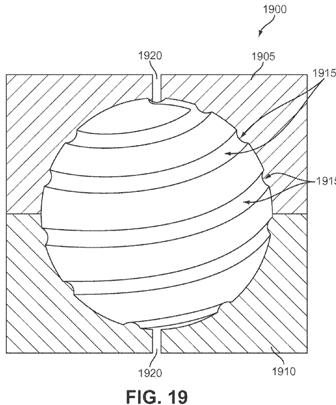
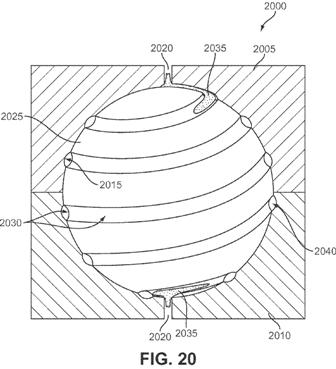
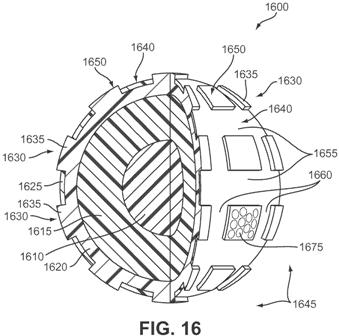
The application goes on to explain.
[0069] In some embodiments, an exemplary disclosed golf ball may include features that provide increased spin and/or feel when struck. In order to provide such characteristics, the golf ball may be provided with one or more components formed of a material having an increased compressibility. That is, the material may deflect a greater amount when exposed to a given amount of force than a relatively less compressible material. In order to provide increased spin and/or feel, such compressible material may be disposed radially outward from the center of the ball, for example at or near the outer surface of the ball.
[0070] It is generally desirable for a golf ball to exhibit minimal spin when struck with a driver. Further, when a golf ball is struck with a club moving at a relatively high club head speed, such as a driver, the amount of deformation of the ball is significant, such that the properties of the core and other inner layers of the ball determine the playing characteristics, particularly distance. For these reasons, it may be desirable to provide a golf ball with a relatively hard and incompressible outer cover layer. An outer cover layer that is too compressible may be too “grippy” and thus produce more spin, even when struck with a driver. Further, a compressible outer cover layer would tend to absorb some of the energy of the impact with the club head and, therefore, reduce the distance achievable with the ball.
[0071] During short game play, however, it may be desirable for a golf ball to exhibit greater amounts of spin and feel. Greater amounts of spin facilitate greater control of the ball. During short game play, where club head speeds are relatively slower, the compressibility of the cover layers of the ball determine the playing characteristics, since the ball is not typically struck hard enough to compress the inner layers of the ball. Increased spin may be provided by a compressible outer cover layer material. Further, such a compressible outer cover layer may also provide improved feel of the ball when struck at relatively slow club head speeds. Thus, the desirability of having a compressible cover for short game play (e.g., playing with irons) may be in conflict with the desirability of having a relatively incompressible cover for long game play (e.g., hitting with a driver).
[0072] The present disclosure provides ball configurations, which implement both compressible and incompressible materials in the cover in order to produce a ball that has both good distance with low spin when struck with a driver, and increased spin and feel when struck with a short game club (e.g., irons, pitching wedge, sand wedge). In some embodiments, an exemplary disclosed golf ball may include one or more core layers and one or more cover layers. In some embodiments, an outermost cover layer, formed of a first material, having formed therein one or more grooves. For example, such grooves may include one or more channels, which may be formed in any suitable configuration. In some embodiments, for example, the outermost cover layer may include at least one spiral channel. In some embodiments, the cover layer may include circular grooves or circumferential grooves, which may be arranged in a grid about the outer surface of the ball.
[0073] In order to provide the increased spin and/or feel, a relatively compressible material may be disposed within the one or more grooves. Such material may have a compressibility that is less than the compressibility of the outermost cover layer material. In some embodiments, the outer cover layer material may constitute a substantial majority of the outer surface area of the golf ball and the outer surface of the material disposed in the grooves may constitute a substantial minority of the outer surface area of the golf ball.
[0074] In some embodiments, the golf ball may include features that affect the aerodynamics of the ball. For example, in some embodiments, the outer surface of the material disposed in the grooves may extend beyond or may be recessed from the outer surface of the outermost cover layer. Therefore, the ball may include either bulges and/or recesses in the outer surface, which may have an effect on aerodynamics. In some embodiments the aerodynamic effect may be a reduction in drag coefficient, to improve distance and/or spin. In other embodiments, the effect may be an increase in drag coefficient, possibly in exchange for increased or decreased spin and/or control. In some embodiments, the orientation of the bulges and/or recesses may induce spin during flight. For example, a spiral arrangement of elongate bulges and/or recesses may cause a particular spin of the ball during flight.
.
.
.
[0077] According to exemplary disclosed embodiments, spin and/or feel of the golf ball may be increased by the inclusion of a relatively compressible material at and/or near the outer surface of the outer cover layer. In some embodiments, a second material may be molded into the grooves of the outer cover layer, wherein the second material has a compressibility that is different than the compressibility of the outer cover layer material. For example, in some embodiments, a material that is more compressible than the outer cover layer material may be molded into the groove
s. In other embodiments, the outer cover layer material may be more compressible than the material molded into the grooves. Although the material molded into the grooves (“groove material”) may be more or less compressible than the outer cover layer, for purposes of discussion, the embodiments discussed below, unless otherwise noted, will be described as having a groove material that is more compressible than the outer cover layer material.[0078] In some embodiments, the outer surface of the groove material forms a portion of the outer surface of the ball. The surface area and thickness of the groove material may be factors in the extent to which the groove material affects the spin and feel of the ball. Generally, the greater the amount of exposed surface area and/or thickness of a compressible material, the greater the increases in spin and feel will be. A compressible material will exhibit more grip against the club face, much like a soft compound tire provides more road grip. Therefore the amount of compressible material surface area will affect the amount of grip the ball will have against the club face. This increase in grip provides more spin and feel when striking the ball. In addition, the thickness of the compressible material has a similar effect on grip, the thickness of the compressible material is related to the amount of compressible material present at the outer portion of the ball. The more compressible material present at the outer portion of the ball, the more the outer portion deforms when struck, even on short game strikes, which tend to be less forceful.
[0079] In order to limit the increase in spin provided by the inclusion of compressible groove material, the groove material may constitute a limited amount of the outer surface area of the ball. For example, in some embodiments, the outer surface of the outer cover layer may constitute a substantial majority of the overall surface area of the ball, and the outer surface of the groove material may constitute a substantial minority of the outer surface of the ball. In other embodiments, the outer surface of the groove material may constitute a substantial majority of the outer surface area of the ball, and the outer surface of the outer cover layer may constitute a substantial minority of the outer surface area of the ball. This configuration may be advantageous, for example, when the outer cover layer material is more compressible than the groove material.
[0080] In addition, the extent to which the groove material extends radially beyond the outer surface of the outer cover layer may also influence the spin and feel. In some embodiments, the groove material may partially fill the grooves, and thus, may have an outer surface that is recessed from the outer surface of the outer cover layer. In some embodiments, the groove material may completely fill the grooves. For example, in some embodiments, the outer surface of the groove material may be substantially flush with the outer surface of the outer cover layer. In some embodiments, the outer surface of the groove material may overfill the grooves, bulging out such that the outer surface of the groove material extends radially outward beyond the outer surface of the outer cover layer. Generally, the greater the distance of a groove material from the center of the ball (relative to the outer surface of the outer cover layer), the greater the increases in spin and feel. The further the groove material extends radially, the more surface area of the groove material will be engaged by the club face and the less surface area of the outer cover layer will be engaged by the club face, thus providing increased grip against the club face, resulting in increased spin and feel.
Come on, if Nike would bring a ball like this to the market I promise to purchase at least 10 dozen, and I suspect there are millions of golfers like me willing to try something a little unconventional. On second thought, since my handicap keeps trending higher put me down for 20 dozen!
David Dawsey – Keeping an Eye on Golf Ball Patent Applications
PS – click HERE to read about a spin indicating golf ball that changes colors
